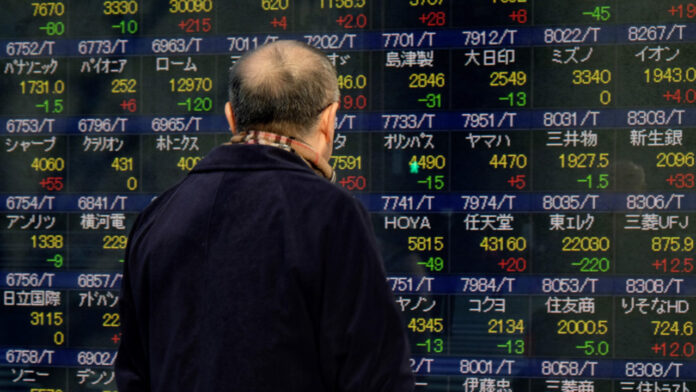Asian shares sank on Monday as the latest salvos in the Sino-U.S. trade war shook confidence in the world economy and sent investors steaming to the safe harbor of sovereign bonds and gold, while slugging emerging market currencies.
People walk past an electronic board showing Japan’s Nikkei average outside a brokerage in Tokyo, Japan, October 15, 2018. REUTERS/Toru Hanai
Global stocks looked set to follow Asia’s slide, with E-Mini futures for the S&P 500 falling 0.7%, and EUROSTOXX 50 futures down 1.1%.
Yields on benchmark 10-year Treasury debt dropped to their lowest since mid-2016, while gold hit its highest since April 2013 as risk was shunned.
On Friday, U.S. President Donald Trump announced an additional duty on some $550 billion of targeted Chinese goods, hours after China unveiled retaliatory tariffs on $75 billion worth of U.S. goods.
China’s onshore yuan fell 0.6% to new 11-year lows. But there was some relief that the central bank fixed the official midpoint at a relatively steady 7.0570 per dollar when it had been trading as weak as 7.1850 offshore, countering concerns Beijing would let the currency slide to keep exports competitive amid mounting U.S. tariffs.
MSCI’s broadest index of Asia-Pacific shares outside Japan shed 2.0%, and Australia 1.5%.
Japan’s Nikkei lost 2.1%, while Shanghai blue chips fell 1.2%.
“Downside risks are increasing for both the global economy and markets,” said Mark Haefele, global chief investment officer at UBS. “As a result, we are reducing risk in our portfolios by moving to an underweight in equities to lower our exposure to political uncertainty.”
“We continue to favor carry strategies in credit and foreign exchange markets, which benefit from central bank easing in a low-growth environment.”
Trump’s new tariff measures were announced after U.S. markets closed on Friday. But Wall Street had nose-dived earlier in the session after Trump said U.S. companies should “immediately start looking for an alternative to China”, in response to Beijing’s latest retaliation.
At the G7 meeting in France over the weekend, Trump caused some confusion by indicating he may have had second thoughts on the tariffs.
But the White House said on Sunday that Trump wished he had raised tariffs on Chinese goods even higher last week, even as he signaled he did not plan to follow through with a demand that U.S. firms close operations in China.
Trump is now set to hold a joint news conference with French President Emmanuel Macron later on Monday.
The latest trade escalation overshadowed a pledge by Federal Reserve Chair Jerome Powell to “act as appropriate” to keep the U.S. economy healthy, although he stopped short of committing to rapid-fire rate cuts.
The markets clearly believe the Fed will have to act more aggressively and are fully priced for at least a quarter-point cut in September and more than 120 basis points of easing by the end of 2020.
“Trump shows no signs of moderating his destructive trade policies,” said JPMorgan analyst Adam Crisafulli.
“Central banks can’t fully ameliorate the downside of a global trade war,” he added. “Companies will enter lockdown mode in terms of spending, and eventually hiring, until at least the November 2020 election amid all the uncertainty.”
More




